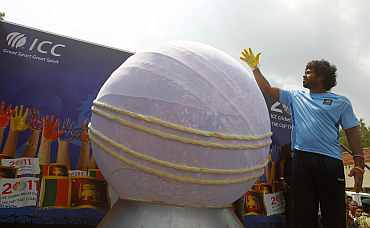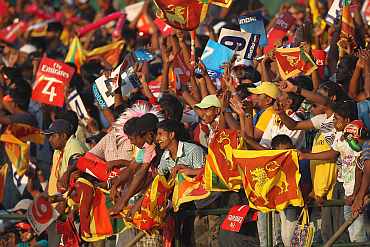
The first sights that greet a visitor at the Colombo airport are billboards that reach out on cricket's behalf: 'Ayubowan! Welcome to where cricket is a way of life,' 'Welcome to a cricket loving nation,' Come, share our passion for cricket,' Get set to eat, breathe, and live cricket.'
Next up is Mahela Jayawardene, staring at you while following through on his signature flick off the pads.
Then, there is an animated Murali appealing, on his haunches, torso sticking out, arms bent back and pointed heavenwards, and his eyes a pair of blazing balls of fire.
Before you gather yourself, you run into Tilakaratne Dilshan, signing off for the cameras after his trademark off-drive. Skipper Sanga the sanguine follows, and the jamboree is rounded off by the animalistic Malinga.
Only after you are acquainted with these gent-giants of Sri Lankan cricket do you get to say hi to the mandatory high-perched photograph of Sri Lankan President Mahinda Rajapakse smiling down on you.
The obligatory presidential photo-op done, it is cricket all the way. In the duty free shops, as you exit the airport, at traffic islands, from billboards, at the roundabouts, these images repeat themselves till you reach the heart of the city.
Surprisingly, there are also Shahid Afridi, and Ricky Ponting, captains of the two nemesis teams in the group, in their signature shuffles -- Ponting shaping up for that short arm jab-pull, and Afridi completing his inside-out hoist.
How much Sri Lanka knows -- and loves -- its cricket is exemplified by the presence of the Shane Watson and the Ross Taylor cut-outs one easily the standout ODI performer of recent times, papering over his country's batting and bowling shortcomings singlehandedly and the other who thrilled the Lankan crowds with a blistering century on his birthday -- alongside these biggies.
Even in the city, there is ample excitement about the cricket, with people -- though they crib and whine about the hardships they faced in getting match tickets -- lauding and supporting Pakistan and Australia in their matches played here, irrespective of the fact that these two teams might put the home team in a tight spot in the quarter-finals.

That brings us to the question: Why does India lack the kind of excitement witnessed in Lanka and Bangladesh?
A hack asked this same question to Indian skipper Mahendra Singh Dhoni, when Team India returned from its only away match -- the opener against Bangladesh.
Why is there no excitement in India, the scribe asked ahead of India's match against the Netherlands in New Delhi.
Dhoni, for all his candour and nonchalance, deadpanned with a cliche for this one: "India is a huge country," he said. "Bangladesh is not. So the reactions are only going to be proportionate."
Ignore the ICC Cricket World Cup copybook captainspeak, and you get the real answers.
Most of Bangladesh's matches have seen the hosts appear. Sri Lanka got the marquee permutations among themselves, Australia, Pakistan and the erratic New Zealand but made the minnows in their group to fly to India.
India has seen classics like, just to sample, Zimbabwe-Canada and Kenya-Canada, Zimbabwe-Kenya.
It thus hosted classic non-entity vs non-entity clashes complemented by Test-playing nations playing against associates with the same intensity as when paint dries.
One shudders to think what would have happened to the Indian leg of the world cup but for England's determination to see more funerals than an undertaker.
Trust the Barmy Army has a heart surgeon or two in its ranks in Colombo for the England-Sri Lanka QF.

No, it was not Australia v Pakistan.
Last Friday, Sri Lanka went to local body polls, which the ruling party won.
On the day of elections, there was a huge and colourful procession going through the city.
In India, no campaigning is allowed from the day before polling. So, slightly taken aback, I asked a shopkeeper if it was okay to campaign on polling day.
I was told it was not a political procession, but one by the supporters of the Royals, a famed local school.
It turns out that the Royals and St Thomas, another equally fabled school, have a famous cricketing rivalry running back to over 130 years. That makes them a longer running rivalry than the Ashes. These matches are called the Royal Thomian, or simply the Big Match. (Check out the graphic in this story to know more about them.)
Even when some international teams are playing in Sri Lanka, this match takes precedence with alumni from both schools flying in from all parts of the world just for the three-day match.
Explaining the importance of school cricket in Sri Lanka, critically acclaimed author of the eminently readable Chinaman, Shehan Karunatilaka, told rediff.com: "Up till quite recently, school cricket was our only island-wide competition.
"The club scene that fed the national team revolved mostly around Colombo. School rivalries go back to the 19th century and the big matches still draw stadiums of support. Maybe it's because there wasn't much money in domestic cricket until the 90s. So school cricket was the most professional expression of the game for most of our history."

If there is one team that is more entertaining than the Pakistan cricket team, it is the Pakistan press corps.
As Waqar Younis came to field questions from the press instead of the skipper after the win against Australia, there was more than a whisper that the skipper was avoiding the press following his rash dismissal (While on that, isn't it time to honor the mercurial Pathan by naming a mode of dismissal in his honour? For example, did you see how Kieron Pollard Afridied himself in Chennai?)
The latter half of a Pakistani journalist's two-part question was: "Is the captain afraid to come here because of his bad shot?"
The question was perfectly audible and Waqar lucidly answered the first part. Then he did an Advani and feigned selective deafness as he looked away, seemingly for the next question.
If he was looking for respite, there was none coming. Because the next question was a reverse swinging Yorker homing in on its very inventor.
"I am a bowler myself," thundered a young Pakistani scribe, "and you are the best reverse swing exponent ever. Did you notice how Lee was getting it to reverse so much in his second spell? Did you find anything fishy the way he was getting the ball to bend? I think there is some foul play. Do you agree?"
As a gaping Waqar looked on speechless, it was left to the otherwise genial ICC manager Sami ul-Hassan to intervene. "You don't need to answer that," he said animatedly.
The press was having none of it. The final question was: "Did the president call to congratulate the team?"
But the gem, though, had to be this question after Kamran 'Teflon' Akmal dropped Ross Taylor on 0, 8, 16, 24, 32, 40, 48, 56, and 64 on his way to a blazing century.
"Coach, what is the difference between Kamran Akmal and Michael Jackson because both wear gloves for no reason?"
As the ICC media manager again dove in to save Waqar, the coach put on a brave face and said "No, no. I will answer that. The difference is one is dead."